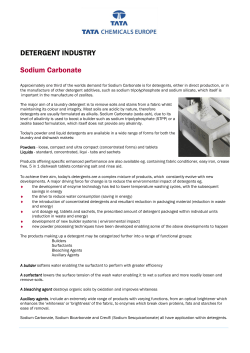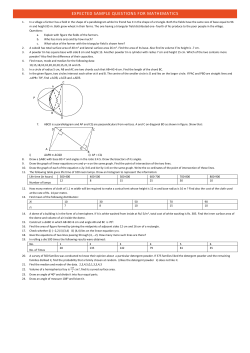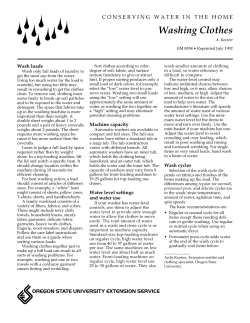
TECHNICAL BULLETIN
ProteoPrep Detergent Sample Kit Catalog Number PROTDT TECHNICAL BULLETIN Product Description The ProteoPrep Detergent Sample Pack contains 10 detergents, non-ionic and zwitterionic, for solubilization of membrane proteins. These detergents allow for testing and optimizing extractions depending upon the protein of interest and cell type. Analysis of membrane proteins in two dimensional (2D) gel electrophoresis is difficult since these proteins are not very soluble under low salt conditions. The detergents in this pack have all been shown to improve solubility in this application. Addition of 7 M urea and 2 M thiourea to many of these detergents has been shown to be very effective in solubilizing membrane proteins from human red blood cells and leaf membranes.17 Since different membrane proteins may require different detergents or combinations of detergents it must be determined by the researcher which detergents are the most effective for the target protein(s) of interest. In general, biological detergents are most commonly used to disrupt the bipolar lipid membrane of cells in order to first free and then solubilize membrane-bound proteins. Some detergents can also be used to solubilize recombinant proteins, while others find their usage in the stabilization, crystallization, or denaturation of proteins. The value of detergents is derived from their amphiphilic nature. Each detergent molecule is characterized by a hydrophilic “head” region and a hydrophobic “tail” region. The result of this characteristic is the formation of thermodynamically stable micelles with hydrophobic cores in aqueous media. This hydrophobic core provides an environment that allows for the dissolution of hydrophobic molecules or domains of proteins. For a given application, the choice of a suitable surfactant depends on a number of variables, from its solubility, polarity, and micelle size to the mechanism of 1-4 its action with the target solute. When selecting a detergent, the first consideration is usually the ionic form of the hydrophilic group, which is either ionic, zwitterionic, or non-ionic. Ionic detergents typically modify protein structure to a greater extent than the other two classes. The degree of modification varies with the individual protein and the particular detergent. Ionic detergents are also more sensitive to pH, ionic strength, and the nature of the counter ion, and can interfere with charge-based analytical methods. Alternatively, most non-ionic detergents are non-denaturing, but are less effective at disrupting protein aggregation. Zwitterionic detergents uniquely offer intermediate properties that are superior to the other detergent types in some applications. Having the low-denaturing and net-zero charge characteristics of non-ionic detergents, zwitterionics also efficiently disrupt protein aggregation. Ease of removal or exchange is often a factor in the selection of a detergent. Some of the more common removal methods include dialysis, gel filtration chromatography, hydrophobic adsorption chromatography, and protein precipitation. The Critical Micelle Concentration (CMC) associated with a detergent is a useful guide to hydrophobic binding strength, the higher the CMC, the weaker the binding and the easier the removal. Another useful parameter is the micelle molecular weight, which indicates relative micelle size. In most cases, the smaller the micelle, the easier the removal. If protein-detergent complexes are to be separated based on the molecular size of the protein, a small micelle size is usually preferred. 2 Zwitterionic Detergents: CHAPS is a non-denaturing, zwitterionic detergent for solubilizing membrane proteins and breaking proteinprotein interactions.6,7 It is commonly used for protein solubilization in isoelectric focusing (IEF) and 2D electrophoresis,8-10 especially for non-denaturing IEF. CHAPS has been shown to give excellent resolution of 11,12 13 some subcellular preparations and plant proteins. Concentrations between 1–4% (w/v) are typically used in an IEF gel.9,14 A commonly used IEF sample solution consists of 8 M urea, 4% CHAPS, 50–100 mM dithiothreitol (DTT), and 40 mM Tris.14 Furthermore, its small micellar molecular weight and high critical micellar concentration allow it to be removed from samples by dialysis. ASB-14 is a zwitterionic detergent for the solubilization of proteins.19,20 It is commonly used in IEF and 2D electrophoresis at a concentration of 1–4%.17 ASB-14 has been shown to solubilize integral membrane 18 proteins from E. coli. ASB-14 is soluble in water (up to 50 mg/ml). As a solid, ASB-14 should be stored at 2–8 °C and should remain stable for at least 2 years. Solutions are stable at 2-8 °C for 1 month. O H3C N H N H3C SO3 CH3 CHAPS is soluble in water (up to 50 mg/ml). 3-(Decyldimethylammonio)propanesulfonate inner salt (SB3-10) is a zwitterionic detergent for the solubilization of outer membrane proteins. It is used in 2D electrophoresis, usually at a concentration of 2%.18 As a solid, CHAPS should be stored at room temperature and should remain stable for at least 2 years. Solutions are stable at 2–8 °C for 1 month. OH CH3 H HO H H CH3 CH3 O CH3 N H SB3-10 is soluble in water (up to 100 mg/ml). O N S CH3 O O H As a solid, SB3-10 should be stored at room temperature and should remain stable for at least 2 years. Solutions are stable at 2–8 °C for 1 month. H OH O O C7BzO is a zwitterionic detergent for the solubilization of proteins.15,16 It is commonly used in IEF and 2D electrophoresis at a concentration of 1–4%. C7BzO has been shown to give excellent resolution of plant 17 proteins. OH H3C CH3 N CH3 C7BzO is soluble in water (up to 50 mg/ml). As a solid, C7BzO should be stored at room temperature and should remain stable for at least 2 years. Solutions are stable at 2–8 °C for 1 month. SO3 O S H3C N CH3 CH3 3 Non-ionic detergents: n-Dodecyl β-D-Maltoside is a non-ionic detergent used for solubilizing membrane proteins from red blood cells and plants.17 n-Dodecyl β-D-maltoside is soluble in water (up to 50 mg/ml). As a solid, n-Dodecyl β-D-maltoside should be stored at –20 °C and should remain stable for at least 2 years. Solutions are stable at 2–8 °C for 1 month. CH2OH CH2OH O O O OH CH3 Octyl β-D-glucopyranoside is soluble in water (up to 100 mg/ml). OH OH O OH OH Octyl β-D-1-thioglucopyranoside (OTG) is a non-ionic detergent used for solubilizing membrane proteins and for the dissociation of protein complexes. It is easily removed from aqueous solutions by dialysis.30,31 Octyl β-D-1-thioglucopyranoside is soluble in water (up to 20 mg/ml). As a solid, Octyl β-D-1-thioglucopyranoside should be stored at –20 °C and should remain stable for at least 2 years. Solutions are stable at 2–8 °C for 3 days. HOCH2 H O H OH S H H OH H OH (CH2)7 Octyl β-D-glucopyranoside (OG) is a non-ionic detergent commonly used in the solubilization of membrane proteins and phospholipids. It has been used to solubilize membrane proteins during extractions and in polyacrylamide gel electrophoresis, both at a concentration of 30 mM.21-23 It has been used at molar dependant ratios for the solubilization of phosphatidylcholine bilayers.24 Because of its relatively high CMC, it is easily removed from aqueous solutions by dialysis25 or by gel filtration.26 Octyl β-D-gluco-pyranoside has 27 been used for protein crystallization, as well as for enhancement of oligosaccharide cleavage from glycoproteins using endoglycosidase F.28 CH3 As a solid, Octyl β-D-glucopyranoside should be stored at –20 °C and should remain stable for at least 2 years. Solutions are stable at 2–8 °C for 3 days. HOCH2 H O H OH O H H OH H OH (CH2)7 CH3 4 Brij C10 is a non-ionic detergent used for solubilizing 17 membrane proteins from red blood cells and plants. Brij C10 is soluble up to 2% (w/v) in a solution of 7 M urea with 2 M thiourea. TRITON X-100 as the neat liquid should be stored at room temperature and should remain stable for 2 years. A 10% solution should be stored at 2–8 °C and should remain stable for 1 month. If formation of trace peroxides is critical to usage, storage under an inert gas at 2–8 °C is advised. As a solid, Brij C10 should be stored at room temperature and should remain stable for at least 2 years. Solutions are stable at 2–8 °C for 1 month. H3C O O O O O O O O O O O O O O H3C C CH3 CH2 C CH3 O O CH3 O O O TRITON X-100 is soluble in all proportions in water, benzene, toluene, xylene, trichloroethylene, ethylene glycol, ethyl ether, ethanol, isopropanol, and ethylene dichloride.5 CH3 O x = 9-10 OH TRITON X-100 has a structure similar to that of IGEPAL CA-630 and of Nonidet P-40 (no longer commercially available); the names are sometimes reported as synonyms.32 However, TRITON X-100 is slightly more hydrophilic than IGEPAL CA-630, and the two are not considered to be functionally interchangeable in most applications. TRITON X-100 is a nonionic, non-denaturing detergent, which is often used in biochemical applications to solubilize proteins. For lysing cells, typically a 0.1% TRITON X-100 solution in water is sufficient and up to 0.5% concentrations will usually not harm most 33 enzymes. (OCH2CH2)xOH Polyoxyethylene 10 tridecyl ether (C13E10) is a nonionic detergent used for solubilizing membrane proteins from red blood cells and plants.17 Polyoxyethylene 10 tridecyl ether (C13E10) is soluble in all proportions in water. As packaged, Polyoxyethylene 10 tridecyl ether (C13E10) should be stored at room temperature and should remain stable for at least 2 years. Solutions are stable at 2–8 °C for 1 month. H 3C HO O O O O O O O O O O 5 Detergent CHAPS C7BzO ASB-14 SB3-10 n-Dodecyl β-D-Maltoside OG OTG Polyoxyethylene 10 tridecyl ether (C13E10) Brij C10 TRITON X-100 Catalog Number Description Molecular Weight C9426 C0856 A1346 D4266 Zwitterionic Zwitterionic Zwitterionic Zwitterionic 615 400 435 308 Critical Micelle Concentration (CMC) (mM) 6 ND ND 25-40 10 ND ND 41 Micelle Molecular Weight 6,150 ND ND 12,600 D4641 Nonionic 511 0.15 98 50,000 O8001 O6004 Nonionic Nonionic 292 308 20-25 9 84 ND 25,000 ND P2393 Nonionic 640* 0.125 ND ND P5759 T8532 Nonionic Nonionic 683* 625* 0.002 0.2-0.9 ND 100-155 ND 80,000 Aggregation Number * Designates detergent with average molecular weight based on content of the various polymers ND = not determined Components CHAPS (Catalog Number C9426) C7BzO (Catalog Number C0856) ASB-14 (Catalog Number A1346) 3-(Decyldimethylammonio)propanesulfonate inner salt (Catalog Number D4266) Dodecyl β-D-maltoside (Catalog Number D4641) Octyl β-D-glucopyranoside (Catalog Number O8001) Octyl β-D-1-thioglucopyranoside (Catalog Number O6004) Polyoxyethylene 10 tridecyl ether (C13E10) (Catalog Number P2393) Brij C10 (Catalog Number P5759) TRITON X-100 (Catalog Number T8532) 1g 1g 1g 1g 1g 1g 1g 1g 1g 1 ml Precautions and Disclaimer This product is for R&D use only, not for drug, household, or other uses. Please consult the Material Safety Data Sheet for information regarding hazards and safe handling practices. 6 References 1. Grant, D.A., and Hjerten, S., Biochem. J., 164, 465468 (1977). 2. Slinde, E., and Flatmark, T., Biochem. Biophys. Acta, 455, 796-508 (1976). 3. Le Maire, M. et al., Eur. J. Biochem., 129, 525-532 (1983). 4. Neugebauer, J.M. et al., Methods in Enzymology, 182, 239-282 (1990). 5. Supplier data (TRITON X-100 is a product of Union Carbide.) 6. Pasquali, C. et al., Electrophoresis, 18, 2573-2581 (1997). 7. Banerjee, P. et al., Chem. Phys. Lipids, 77, 65-78 (1995). 8. Hjelmeland, L.M., and Chrambach, A., Electrophoresis, 2, 1-11 (1981). 9. Garfin, D.E., Methods in Enzymology., 182, 459477 (1990). 10. Schupbach, J. et al., Anal. Biochem., 196, 337-343 (1991). 11. Perdew, G.H. et al., Anal. Biochem., 135, 453-455 (1983). 12. Fialka, I. et al., Electrophoresis, 18, 2582-2590 (1997). 13. Holloway, P.J., and Arundel, P.H., Anal. Biochem., 172, 8-15 (1988). 14. Herbert, B., Electrophoresis, 20, 660-663 (1999). 15. Molloy, M.P. et al., Electrophoresis, 19, 837-844 (1998). 16. Rabilloud, T. et al, Electrophoresis, 20, 3603-3610 (1999). 17. Luche, S. et. al., Proteomics, 3, 249-253 (2003). 18. Molloy, M.P. Analytical Biochemistry, 280, 1-10 (2000). 19. Molloy, M.P. et al., Electrophoresis, 20, 701-704 (1999). 20. Chevallet, M. et al., Electrophoresis, 19, 1901-1909 (1998). 21. Baron, C., and Thompson, T.E., Biochim. Biophys. Acta, 382, 276 (1975). 22. Lazo, J.S., and Quinn, D.E., Analytical Biochemistry, 102, 68 (1980). 23. Han, S., and Tanzer, M.L., J. Bio. Chem., 254, 10438 (1979). 24. Jackson, M.L. et al., Biochemistry, 21, 4576 (1982). 25. Lorber, B. et al., Biochim. Biophys. Acta., 1023, 254 (1990). 26. Mimms, L.T. et al., Biochemistry, 20, 833 (1981). 27. Moller, J.V. et al., Progress in Protein-Lipid Interactions, Vol. 2, Chap. 5, Elsevier, (New York, NY: 1985). 28. Stuebe, K. et al., Biochemistry, 20, 6776 (1985). 29. Keesey, J. ed., Biochemica Information, 1st ed., p. 194 (1987). 30. Saito, S., and Tsuchiya T., Biochem J., 222, 829832 (1984). 31. Yoshida, M., Eur. J. Biochem., 222, 1055-1061 (1994). 32. The Merck Index, 12th ed., #6858 (1996). 33. Sigma data. ProteoPrep is a registered trademark of Sigma-Aldrich Biotechnology LP and Sigma-Aldrich Co. Brij is a registered trademark of Croda International PLC. TRITON is a registered trademark of Dow Chemical Co. IGEPAL is a registered trademark of Rhodia Operations. JRW,RJM,MAM 07/10-1 Sigma brand products are sold through Sigma-Aldrich, Inc. Sigma-Aldrich, Inc. warrants that its products conform to the information contained in this and other Sigma-Aldrich publications. Purchaser must determine the suitability of the product(s) for their particular use. Additional terms and conditions may apply. Please see reverse side of the invoice or packing slip.
© Copyright 2025










